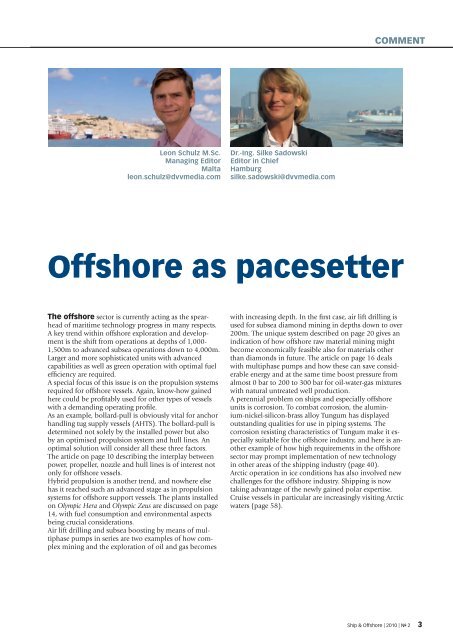| 2 | 2010 - Schiff & Hafen
| 2 | 2010 - Schiff & Hafen
| 2 | 2010 - Schiff & Hafen
You also want an ePaper? Increase the reach of your titles
YUMPU automatically turns print PDFs into web optimized ePapers that Google loves.
COMMENT<br />
Leon Schulz M.Sc.<br />
Managing Editor<br />
Malta<br />
leon.schulz@dvvmedia.com<br />
Dr.-Ing. Silke Sadowski<br />
Editor in Chief<br />
Hamburg<br />
silke.sadowski@dvvmedia.com<br />
Offshore as pacesetter<br />
The offshore sector is currently acting as the spearhead<br />
of maritime technology progress in many respects.<br />
A key trend within offshore exploration and development<br />
is the shift from operations at depths of 1,000-<br />
1,500m to advanced subsea operations down to 4,000m.<br />
Larger and more sophisticated units with advanced<br />
capabilities as well as green operation with optimal fuel<br />
efficiency are required.<br />
A special focus of this issue is on the propulsion systems<br />
required for offshore vessels. Again, know-how gained<br />
here could be profitably used for other types of vessels<br />
with a demanding operating profile.<br />
As an example, bollard-pull is obviously vital for anchor<br />
handling tug supply vessels (AHTS). The bollard-pull is<br />
determined not solely by the installed power but also<br />
by an optimised propulsion system and hull lines. An<br />
optimal solution will consider all these three factors.<br />
The article on page 10 describing the interplay between<br />
power, propeller, nozzle and hull lines is of interest not<br />
only for offshore vessels.<br />
Hybrid propulsion is another trend, and nowhere else<br />
has it reached such an advanced stage as in propulsion<br />
systems for offshore support vessels. The plants installed<br />
on Olympic Hera and Olympic Zeus are discussed on page<br />
14, with fuel consumption and environmental aspects<br />
being crucial considerations.<br />
Air lift drilling and subsea boosting by means of multiphase<br />
pumps in series are two examples of how complex<br />
mining and the exploration of oil and gas becomes<br />
with increasing depth. In the first case, air lift drilling is<br />
used for subsea diamond mining in depths down to over<br />
200m. The unique system described on page 20 gives an<br />
indication of how offshore raw material mining might<br />
become economically feasible also for materials other<br />
than diamonds in future. The article on page 16 deals<br />
with multiphase pumps and how these can save considerable<br />
energy and at the same time boost pressure from<br />
almost 0 bar to 200 to 300 bar for oil-water-gas mixtures<br />
with natural untreated well production.<br />
A perennial problem on ships and especially offshore<br />
units is corrosion. To combat corrosion, the aluminium-nickel-silicon-brass<br />
alloy Tungum has displayed<br />
outstanding qualities for use in piping systems. The<br />
corrosion resisting characteristics of Tungum make it especially<br />
suitable for the offshore industry, and here is another<br />
example of how high requirements in the offshore<br />
sector may prompt implementation of new technology<br />
in other areas of the shipping industry (page 40).<br />
Arctic operation in ice conditions has also involved new<br />
challenges for the offshore industry. Shipping is now<br />
taking advantage of the newly gained polar expertise.<br />
Cruise vessels in particular are increasingly visiting Arctic<br />
waters (page 58).<br />
Ship & Offshore | <strong>2010</strong> | N o 2 3
















